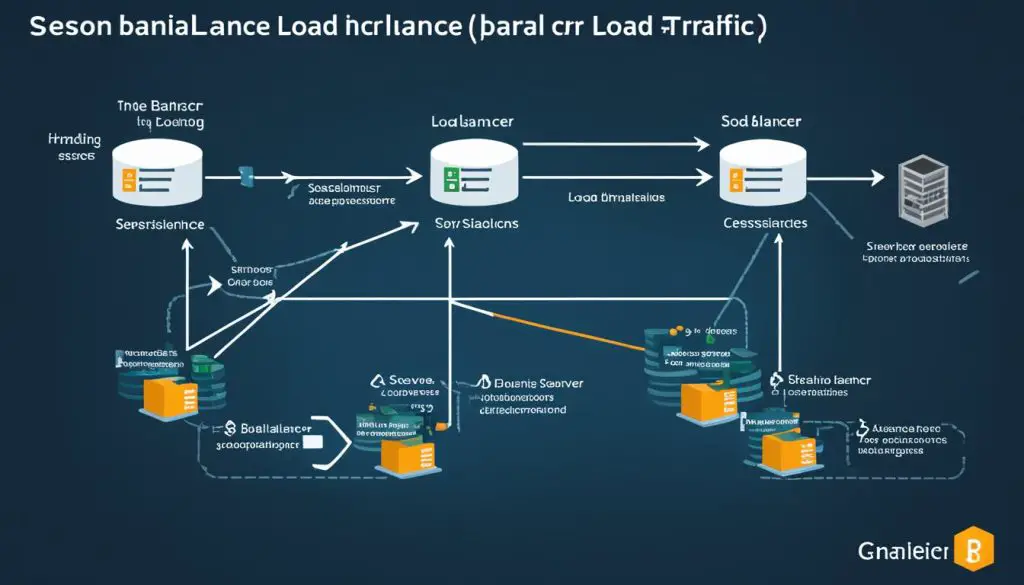Understanding What is a Load Balancer Explained
A load balancer is a crucial component in modern networking that efficiently distributes incoming network traffic across a group of backend servers or server pool. It acts as a “traffic cop” in front of the servers, routing client requests to maximize speed and capacity utilization.
Load balancing is essential for high-traffic websites that need to handle concurrent requests and ensure high availability and reliability. By evenly distributing the workload among servers, load balancers prevent any single server from becoming overwhelmed, improving performance and preventing downtime.
Load balancers can be hardware-based or software-based, offering scalability, redundancy, flexibility, and efficiency. They employ various load balancing algorithms, such as Round Robin and Least Connections, to determine how the incoming requests are distributed among the servers. This ensures optimal resource utilization and provides a seamless user experience.
With a load balancer in place, websites and applications can handle increasing traffic, adapt to changing demand, and provide a reliable and efficient user experience.
Key Takeaways:
- A load balancer efficiently distributes incoming network traffic across a group of backend servers or server pool.
- It acts as a “traffic cop,” routing client requests to maximize speed and capacity utilization.
- Load balancers are crucial for high-traffic websites to handle concurrent requests and ensure high availability and reliability.
- They can be hardware-based or software-based, offering scalability, redundancy, flexibility, and efficiency.
- Load balancing algorithms determine how requests are distributed among servers, optimizing resource utilization.
Benefits of Load Balancing
Load balancing plays a vital role in optimizing the performance of websites and applications. By efficiently distributing network traffic across multiple servers, load balancers deliver a range of benefits that enhance reliability, scalability, and efficiency.
Reduced Downtime
One of the significant advantages of load balancing is its ability to minimize downtime. In the event that a server goes down or becomes unavailable, the load balancer swiftly redirects traffic to the remaining servers. This redirection ensures uninterrupted service for users and prevents any disruptions or gaps in connectivity.
Scalability and Flexibility
Load balancing offers the flexibility to add or subtract servers based on demand. As web traffic fluctuates, load balancers can dynamically adjust the server pool to accommodate the changing load. Scaling up or down in response to demand ensures optimal performance and prevents overloading or underutilization of resources.
Redundancy and High Availability
Load balancers provide redundancy by distributing traffic across multiple servers. This redundancy ensures that even if one server fails, the remaining servers can handle the increased load, maintaining high availability. By eliminating single points of failure, load balancing enhances the reliability and fault tolerance of websites and applications.
Improved Efficiency
Load balancing optimizes the utilization of server resources by distributing client requests across the available servers. This balanced distribution maximizes speed and capacity utilization, resulting in improved overall efficiency. By avoiding bottlenecks and evenly distributing the workload, load balancers ensure smooth and responsive user experiences.
Load Balancer Types and Algorithms
Load balancers play a critical role in efficiently distributing network traffic across multiple servers. To accomplish this, load balancers employ different types and algorithms to ensure seamless operations and optimal performance. Let’s explore the various load balancer types and algorithms that are commonly used in modern networking.
Load Balancer Types
Load balancers can be categorized into two main types: hardware-based and software-based load balancers.
- Hardware-based load balancers utilize specialized processors specifically designed for load balancing tasks. These dedicated hardware appliances offer high performance and can handle large-scale traffic efficiently.
- Software-based load balancers, on the other hand, run on commodity hardware and use software algorithms to distribute traffic. They provide flexibility and cost-effectiveness, making them suitable for a wide range of applications.
Load Balancing Algorithms
The effectiveness of load balancers heavily relies on the load balancing algorithms they employ. These algorithms determine how client requests are distributed among the available servers. Here are some common load balancing algorithms:
- Round Robin: Requests are distributed sequentially among the servers. It ensures an equal load distribution, making it suitable for environments where all servers have similar capabilities.
- Least Connections: Requests are forwarded to the server with the fewest active connections. This algorithm is effective in distributing the load if there is a significant disparity in server capacity or client sessions.
- IP Hash: The algorithm uses the client’s IP address to determine which server to send the request to. This ensures that requests from the same IP address are always directed to the same server, maintaining session persistence.
- Weighted Round Robin: This algorithm assigns a weight to each server based on its capacity or performance. Servers with higher weights receive more traffic, allowing for efficient load distribution according to server capabilities.
Each load balancing algorithm has its advantages and is chosen based on specific requirements. It’s essential to select the most suitable algorithm to achieve optimal performance and resource utilization.
Session Persistence and Dynamic Configuration
Session persistence, also known as sticky sessions, plays a critical role in load balancing by ensuring that client requests are directed to the same server for the duration of a session. Especially in scenarios involving shopping carts or cached information, session persistence is essential for maintaining user sessions and providing a seamless experience.

Load balancers are equipped to handle session persistence as needed, directing client requests to the specific server that initially handled the session. By maintaining continuity for each user session, load balancers enhance the overall user experience and eliminate disruptions caused by switching servers.
Additionally, load balancers offer dynamic configuration capabilities for server groups, enabling seamless scaling based on demand. With the ability to add or remove servers from a server group without interrupting existing connections, load balancers provide the flexibility required for fast-changing applications. This dynamic approach is particularly valuable in cloud environments like AWS EC2, where constant scaling based on fluctuating workloads is crucial.
Conclusion
Load balancers play a crucial role in modern networking, ensuring the efficient distribution of network traffic across multiple servers. They are essential for high-traffic websites that need to handle concurrent requests and ensure high availability.
The importance of load balancers lies in their ability to reduce downtime by redirecting traffic to remaining servers if one goes down. They offer scalability by adding or subtracting servers based on demand, providing the flexibility to adapt to changing traffic patterns. Load balancers also enhance efficiency by distributing client requests across multiple servers, maximizing speed, and capacity utilization.
Load balancers possess a range of functions and features that make them indispensable. They employ various load balancing algorithms, such as Round Robin, Least Connections, and IP Hash, to determine how requests are distributed among servers. Additionally, load balancers can handle session persistence, ensuring that client requests are sent to the same server for the duration of a session, which is crucial for maintaining user sessions in scenarios like shopping carts or cached information.
Load balancers can be implemented using hardware-based or software-based solutions, depending on specific needs. These implementations provide reliability and availability for websites and applications, making load balancers an integral part of modern infrastructure. Whether it’s for managing high-traffic websites, handling concurrent requests, or ensuring high availability and seamless user experiences, load balancers are essential in today’s networking landscape.
FAQ
What is a load balancer?
A load balancer efficiently distributes incoming network traffic across a group of backend servers or server pool. It acts as a “traffic cop” in front of the servers, routing client requests to maximize speed and capacity utilization.
Why is load balancing important?
Load balancing is essential for high-traffic websites that need to handle concurrent requests and ensure high availability and reliability. It reduces downtime, allows scalability based on demand, offers redundancy, provides flexibility to adapt to changing traffic patterns, and improves efficiency by distributing client requests across multiple servers.
What are the different types of load balancers?
Load balancers can be hardware-based or software-based. Hardware-based solutions use specialized processors, while software-based solutions run on commodity hardware.
What load balancing algorithms are commonly used?
Common load balancing algorithms include Round Robin, Least Connections, IP Hash, and Weighted Round Robin. Each algorithm determines how requests are distributed among servers based on specific needs such as sequential distribution, least connections, or client IP address.
What is session persistence and why is it important?
Session persistence, also known as sticky sessions, ensures that client requests are sent to the same server for the duration of a session. This is crucial for maintaining user sessions, especially in scenarios like shopping carts or cached information.
Can load balancers dynamically add or remove servers?
Yes, load balancers can dynamically add or remove servers from a server group without interrupting existing connections. This flexibility is useful for fast-changing applications that require constant scaling based on demand, such as in cloud environments like AWS EC2.
What are the benefits of load balancing?
Load balancing provides several benefits, including reduced downtime, scalability, redundancy, flexibility, and efficiency. It ensures high availability, improves performance, and maximizes speed and capacity utilization.
More Links
- About the Author
- Latest Posts
Mark is a senior content editor at Text-Center.com and has more than 20 years of experience with linux and windows operating systems. He also writes for Biteno.com






